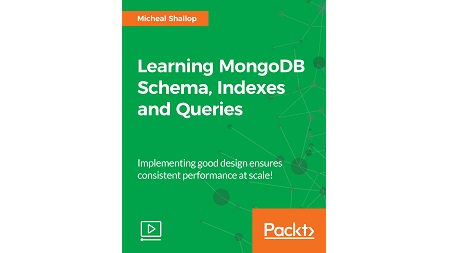
English | MP4 | AVC 1920×1080 | AAC 48KHz 2ch | 6h 27m | 1.40 GB
Understand how good design facilitates scale and achieve top performance by gaining insights into indexing strategies.
MongoDB makes it possible to store and process large sets of data in ways that increase business value. The flexibility of unstructured, schema-less, storage, combined with robust querying and post-processing functionality, make MongoDB a compelling solution for enterprise big data needs.
We need to discuss database schemas. Yes, MongoDB is touted as schema-less but here’s where we show that proper design is what allows our collections to scale. Indexing is something everyone talks about, but few understand. We’ll explain MongoDB indexing, and index properties because a successful indexing strategy is a key to performance and scaling. Finally, we’ll talk about CRUD commands from the MongoDB client and how to write effective queries.
Taking this course will help you understand supported standards and data types in MongoDB, and best practices to design collections to scale and index them. Also, you will learn some basic CRUD commands.
Through real-world and best-practice data schemas, we show you how design impacts performance and show you how to scale your system. We demonstrate the effective use of MongoDB queries for inserting, updating, deleting, and fetching data.
What You Will Learn
- A collection schema matters in a schema-less system; or, when to stop de-normalizing data relationships
- How a data schema impacts scale
- Introduction to database indexing: concepts and terminology
- How indexes increase operational overhead but improve query performance
- MongoDB Indexes vs. index properties
- Advanced index concepts and indexing best-practices
- CRUD commands from the MongoDB client; how to combine simple JavaScript with BSON queries to populate sample tables, and how to use queries effectively to maintain your database
- Administrative queries; how to delete collections or even entire databases.
- How to apply indexes, or query to see what indexes already exist.
- Perform a quick backup and recovery of your collections
Table of Contents
Imposing Schema on a Schema-Less System
1 The Course Overview
2 Schema – Traditional Definition and How It’s Applied To mongoDB
3 Denormalization Defined as a Corollary to Data Normalization
4 Mongo Data Types
Indexes – The Keys to Speed
5 Indexes – What Indexes Do, How They’re Stored, Used, and Their General Impact
6 Index Properties – How Index Properties Can Enhance or Fine-Tune Existing Indexes
7 Index Properties – How Index Properties Can Enhance or Fine-Tune Existing Indexes (Continued)
8 Index Management
9 Index Management (Continued)
10 Index Management – Demo
CRUD
11 Introduction to MongoDb CRUD Queries
12 Create – How to Create New Databases and New Collections
13 Create – How to Create New Databases and New Collections (Continued)
14 Demo for Create Command
15 READ – How to Fetch Data from a Collection
16 READ – How to Fetch Data from a Collection (Continued)
17 Demo for Read Command
18 Update – How to Update Existing Records Within a Single Query
19 Update – How to Update Existing Records Within a Single Query (Continued)
20 Demo for Update Command
21 Demo for Update Command (Continued)
22 Delete – How to Permanently Remove Data from Your Collection
23 Demo for Delete Command
24 Aggregation –How to Write Aggregation Queries
25 Demo for Aggregation
26 Demo for Aggregation (Continued)
Administration of Your Database
27 Maintaining Databases and Collections
28 Moving Your Database to Another Location
29 Demo One – Moving a Database to Another Machine
30 Demo Two – Moving a Database to Another Machine
31 Moving a Collection to Another Database
32 Demo One – Moving a Collection to Another Database
33 Quick and Easy Backup and Recovery
34 Demo – Backup and Recovery
35 Dropping Collections and Databases
36 Demo – Dropping Collections and Databases
Resolve the captcha to access the links!